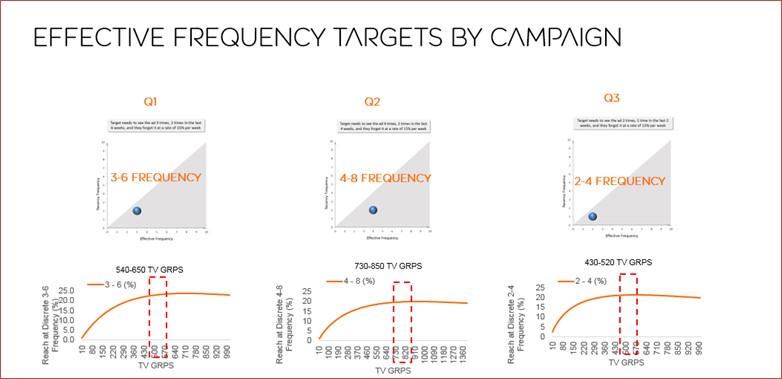WARC from Home is a new series to help subscribers to brush up on the essentials of marketing during the COVID-19 lockdown. Find all WARC from Home content here.
Every week we’ll guide you around the latest thinking on a key topic, pointing you in the direction of must-read articles, seminal research papers and essential webinars, to ensure you are top of the class when we all finally return to office life. This week we’ll be taking a look at frequency.
Since the 1970s, advertisers have crafted media plans to ensure that consumers are exposed to an ad on an optimal number of occasions. Here we summarise the many theories that have been published on frequency management, and share some of the latest thinking on frequency in the era of e-commerce.
What do we mean by frequency?
Frequency describes the average number of times a person within a target audience has an opportunity to see an ad. Too little and the campaign risks having no impact; too much and advertisers are likely to be wasting money, as well as irritating consumers.
The precise nature of that frequency sweet spot has been fiercely contested – a debate excellently summed up by Paul Feldwick here – and channel-specific planners have devised frequency models for every medium, from press and OOH to in-store radio.
It all began in 1972, when Herb Krugman, then head of advertising research at General Electric, proposed three to be the ‘magic number’: one ad to prompt awareness, a second to create recognition, and a third to complete the process, with all subsequent exposures delivering a “psychologically identical” response, he argued.
Krugman’s approach became the industry norm for the next two decades until it was challenged by media planner Erwin Ephron. He instead proposed the idea of “recency planning” and the need for advertisers to constantly build reach, essentially arguing that the effects of advertising decay very rapidly after the ‘opportunity to see’.
Essential reading:
- Advertising reach and frequency by Colin McDonald (Admap Magazine, July 2004)
For a deeper dive:
- Effective frequency: there and back by Simon Broadbent (Admap Magazine, May 1998)
- Recency planning by Erwin Ephron (Journal of Advertising Research, July/August 1997)
So what changed?
Under the influence of Ephron, many advertisers moved away from campaign flights, towards a lighter weight when on air. Yet, in the end, it was Ephron himself that changed his mind.
By 2010, as a result of media fragmentation and commercial avoidance, he had concluded that audience exposure to an ad was “no longer a given”. This view was echoed by Professor Byron Sharp, who in ‘How Brands Grow’ noted that fewer than 20% of TV ads are noticed and correctly branded.
If users are less likely to see ads, then frequency controls appear less imperative. Led by influential research from Sharp and the Ehrenberg-Bass Institute, advertisers began to prioritise the optimisation of audience reach over frequency management – not least due to the difficulties of managing frequency across channels.
However, in recent years marketers such as Procter & Gamble’s Marc Pritchard have returned the issue to the spotlight with a renewed focus on the perils of “excess frequency”. Pritchard proposes that, deployed correctly, programmatic trading technology can be used to control costs and help to avoid ‘wastage’, especially on social platforms.
Essential reading:
- The evolution of effective frequency by Chris Sloane, Gain Theory (Admap Magazine, March 2019)
What impact has digital had on frequency management?
Ephron had hoped that, by replacing the ambiguity of ‘opportunity to see’ with a more specific count of people seeing advertising, the role of frequency in building audiences would become obvious and “easier”.
In reality, digital has added complexity. Research by Comscore found that advertisers must strike an intricate balance to optimise campaign effectiveness across impressions, time and platforms. It suggests a “cool-off period” in the middle of a campaign, before increasing frequency to previous levels to boost repetition and recency effects.
A separate 2019 study by academics from the University of Tampa and Mississippi University for Women concluded that consumers seeing an ad 10 or more times had greater purchase intent than those with less exposure.
Furthermore, e-commerce platforms such as Amazon require their own fresh approach to frequency management. In these environments, brands may benefit from a “more aggressive” frequency of ad exposure, though Flywheel Digital (a sister company of WARC) ultimately recommends “steady messaging” rather than “bombardment”.
Essential reading:
- How to make sense of cross-platform measurement by Sean Pinkney, Comscore (Admap Magazine, March 2019)
- Frequency capping on Amazon by Patrick Miller and Sandy Welsch, Flywheel Digital (Admap Magazine, March 2019)
For a deeper dive:
- Frequency: How much is too much? (Admap Magazine, March 2019)
- Revisiting the relationship between ad frequency and purchase intentions: How affect and cognition mediate outcomes at different levels of advertising frequency by Jennifer Lee Burton, Jan Gollins, Linda E. McNeely, and Danielle M. Walls (Journal of Advertising Research, 2019)
Got any real-life examples?
- Like P&G, UK insurer Direct Line Group has taken a strong stance on ensuring controls on ad exposure frequency, particularly in digital media. Writing for WARC, Marketing Director Mark Evans has argued for the need for cross-platform frequency caps, to ensure transparency over “wasted spend” if frequency is exceeded.
- EasyJet’s award-winning ‘Project Multiscreen’ case study, meanwhile provides a fascinating insight into how the brand’s agency OMD optimised frequency across multiple channels, including broadcast television, online video, social media and OOH (see image below). By doing so, it ensured the advertiser avoided a “long tail of high frequency” – vital given easyJet’s flat media budget and the competitive landscape.

We hope you enjoyed this guide to frequency management and found it useful. You can read up on other essential marketing topics here, and revisit a series of classic webinars. Please do get in touch with the WARC team if you would like to find out more.

